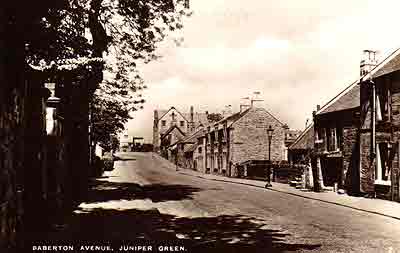The VILLAGE HALL story
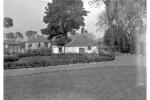
© Royal Commission on the Ancient and Historical Monuments of Scotland. Licensor www.scran.ac.uk
Rents were collected from local farms and this picture shows a byre in Bloomiehall farm
On the 1853 Ordinance Survey map of Edinburghshire, the present site of Juniper Green village hall is marked with a small cluster of farm cottages and a threshing machine at Bloomy Hall Farm, surrounded by open countryside.
In 1888 the local newspaper, the Juniper Green Observer published a letter to the Editor on the subject "Recreation for Young and Old in Juniper Green" stating that a local landowner Sir John Foulis was anxious to obtain a building that could house a library and other attractions for the good of the local residents.
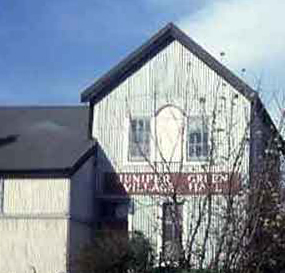
The Village Hall in Juniper Green has been the place for many community activities over the years.
In a map of the area in 1894 the site of the hall is described as 'parkland' which adjoined the newly built 9-hole Baberton Golf Course (1893) which was designed by Willie Park; it was converted into an 18-hole course a year later. Membership of the golf club was restricted initially to residents of the Parish of Colinton & Currie. The village was beginning to take shape with the building of several houses along Belmont Road, Baberton Avenue and Lanark Road. Nothing materialised until 1900 when the present Village Hall was built by the War Department as a Drill Hall. The rifle range for the practice of target shooting was situated in the basement of the hall and is still used today by the Rifle Club. The hall was originally known as the Volunteers' Hall (the equivalent of today's Territorial Army).
In 1910 the Volunteers were disbanded and the hall was purchased from the Army Council for the benefit of the local residents for £375 - which also included the price of the caretaker's house. A house-to-house collection was made in the Village and £50 was raised to go towards this expense.
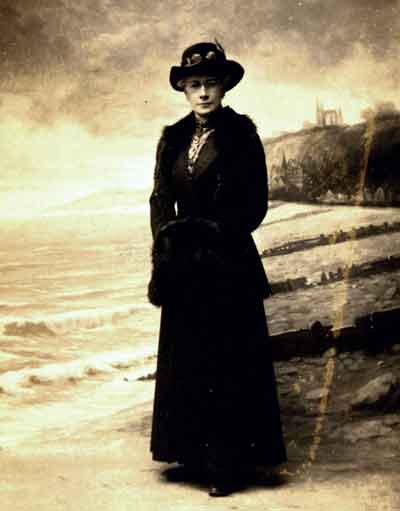
Miss Huffel who lived in the Bield and ran classes for the girls of the village in the early years of the twentieth century
Miss Huffel ran a Young Women's Sewing Club for many years and the Young Men's Club was responsible for organising many social activities such as dances, snooker, badminton, a cinema, weekly whist drives etc.
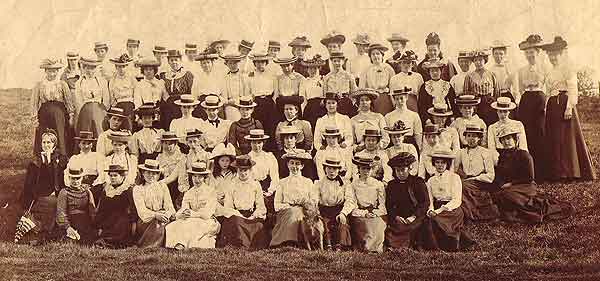
Could this be a group of Juniper Green young ladies being led on an outing by Miss Huffel in the early years of the twentieth century?
For many years the hall was widely used by the local residents. In the Minutes of 1913 it is quoted that there was the opportunity to make use of baths in the Hall (80% of the houses in the Village did not have a bath at this time) and were open to the public for three pence + a penny for a towel. Outsiders, people who did not reside in the Village, were charged four pence! (two pence in today's money).
The possibility of a library was again discussed in 1920 but did not materialise.
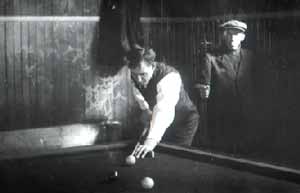
The snooker and billiard tables in the Village Hall gave hours of fun to many in the community
Electricity was installed by St Cuthbert's Co-operative Association in 1935; 39 lights were installed for the price of £39. During the Second World War years the Men's Club was abandoned because of lack of numbers but was re-instated in 1948, every night from 6.30 pm - 10.30 pm and 2 pm - 5 pm on Saturdays for billiards, whist and snooker. Three full-sized snooker tables proved to be very popular. The upper room of the hall was used as a workshop for the British Legion.
By 1957 the Hall was badly in need of repair and Juniper Green Association was formed to represent many of the interests of the residents in the district. Funds were raised, much by door-to-door collections again, to put the hall and caretaker's house in order.

